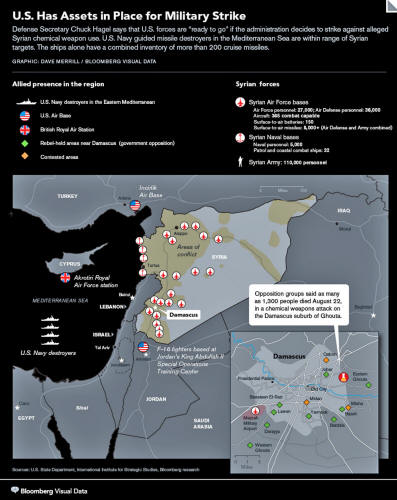|
August 28, 2013 from ZeroHedge Website
As Bloomberg notes in the infographic below, US Navy guided missile destroyers in the Mediterranean Sea are within range of Syrian targets... and the ships have a combined inventory of more than 200 cruise missiles.
On the other side, the Syrian Air Defense system is very robust, and as Stratfor notes, with an estimated 54,000 personnel, Syria's air defense network is twice the size of former Libyan leader Moammar Gadhafi's air force.
Here is the Syrian theater of operations:
With an estimated 54,000 personnel, Syria's air defense network is twice the size of former Libyan leader Moammar Gadhafi's air force and air defense command combined at the start of the NATO campaign in 2011.
Syria's Air Defense Command consists of the 24th
and 26th anti-aircraft divisions, which comprise thousands of anti-aircraft
guns and more than 130 surface-to-air missile (SAM) batteries.
However, the Syrians operate these systems in
far greater numbers, have devoted significant resources to maintaining and
upgrading these missile batteries and have also successfully deployed their
SAM systems in a dense and overlapping layout that would complicate
operations to suppress enemy air defenses.
For example, Iran reportedly financed Syria's acquisition of 50 SA-22 systems first delivered in 2007 - 10 of which allegedly ended up in Iranian hands. The Syrians are also thought to operate several SA-11 systems, which the Libyans did not have.
Syria's defenses against an air campaign are not restricted to the ground.
Its air force can contribute dozens of fighter
aircraft and interceptors, which any intervention force would also have to
contend with.
|


